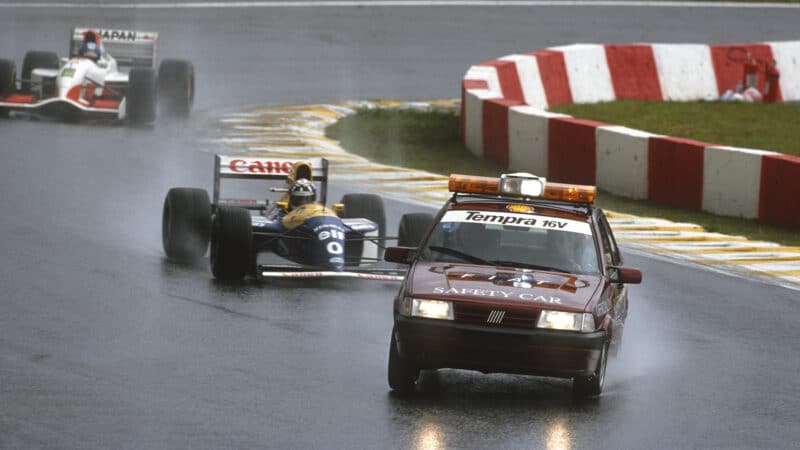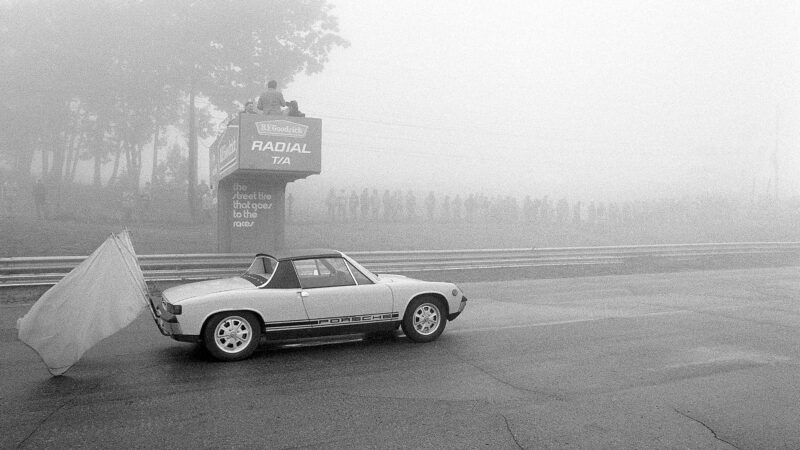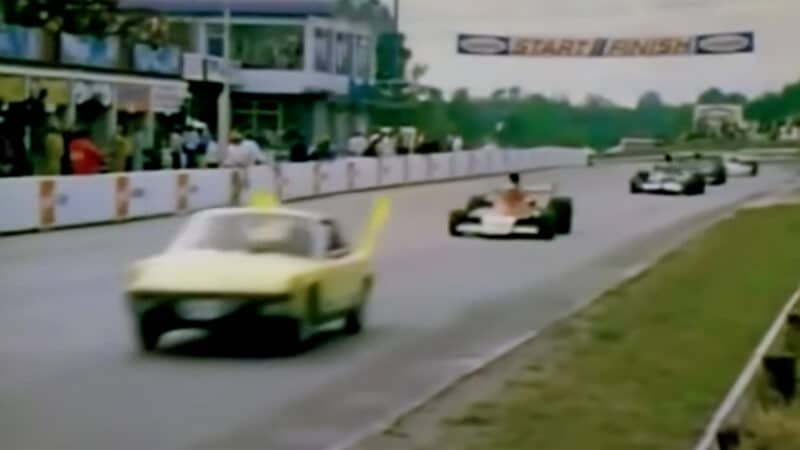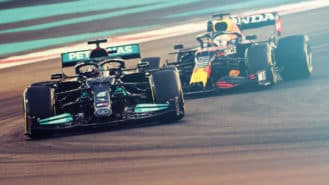Torrential rain flooded the circuit as the race got underway, allowing some new stars to shine through in the awkward conditions — a young Niki Lauda taking the lead on lap three after qualifying eighth. But then came the chaos.
A rapidly drying track forced the majority of the field to pit for slick tyres and after Scheckter and Cevert’s clash, a recovery vehicle was brought out on track to pick up some of the debris. Both instances caused utter confusion in the running order, and in an attempt to regain control of the race, organisers deployed what was then called the pace car on lap 32. It pulled out ahead of Howden Ganley — who had initially been running in 23rd place.
As the Porsche re-entered the pitlane and the final 45 laps of the race were run, it became more and more unclear who the race leader really was. Some thought it to be Emerson Fittipaldi, others claimed Jackie Oliver but it was Ganley’s Williams that initially took the chequered flag.
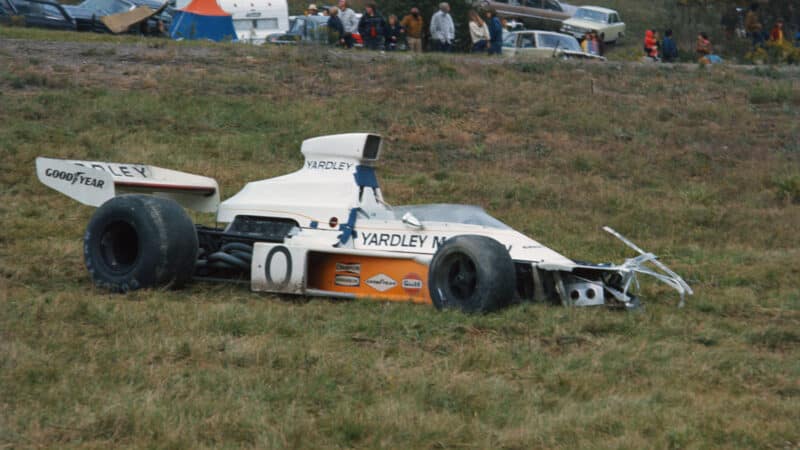
Jody Scheckter’s McLaren wrecked at the side of the road helped make history: the deployment of F1’s first safety car
Grand Prix Photo
Several hours after podium celebrations and scouring lap charts, it appeared some cars had skipped the safety car queue amid the chaos and completed one more lap than the rest of the field. Peter Revson was officially declared the winner, with Fittipaldi in second Oliver in third.
Given its turbulent introduction, it’s little surprise that the safety car’s appearances were sporadic for several years. it didn’t appear again until the 1976 Monaco Grand Prix — a Porsche 911 now leading the pack — and many still doubted the need for one at all.
1980s: an exotic era for F1 safety cars
Widely regarded as Formula 1’s jewel in the crown, the Monaco Grand Prix has always been about the spectacle — the glitz and glamour of the principality on full display since 1950. So why not have a safety car to match?
From 1981-1983, a Lamborghini Countach made some cameo appearances across the race weekend but was never deployed during the grand prix itself — its 4.0-litre V12 instead reduced to the odd parade lap.
Another wouldn’t be seen on track for the next decade.
Safety cars are re-introduced — with a twist
It wasn’t until 1993 that safety cars became a permanent fixture at every race weekend, after the idea was re-trialled at the British and French Grands Prix in 1992. But instead of a single manufacturer supplying one safety car for the entire F1 calendar, each race organiser was responsible for supplying their own — leading to some interesting choices.
A mixture of road cars (some sporting, some less so) were the first alternatives among many: a Fiat Tempra 16v used in the 1993 Brazilian Grand Prix, a Ford Escort Cosworth in the 1992 British Grand Prix a Honda Prelude in the 1992 Japanese Grand Prix and a Opel Vectra during Imola‘s tragic 1994 weekend. Although fan favourites, each were not exactly ideal choices to lead a 20,000 horsepower fleet of F1 cars.
But from the 1996 season onwards — following a Renault Clio Williams appearance at the Argentine Grand Prix — there was some form of order in the supply of safety cars for each grand prix: an agreement reached between F1 and Mercedes.
More muscle for F1 safety cars
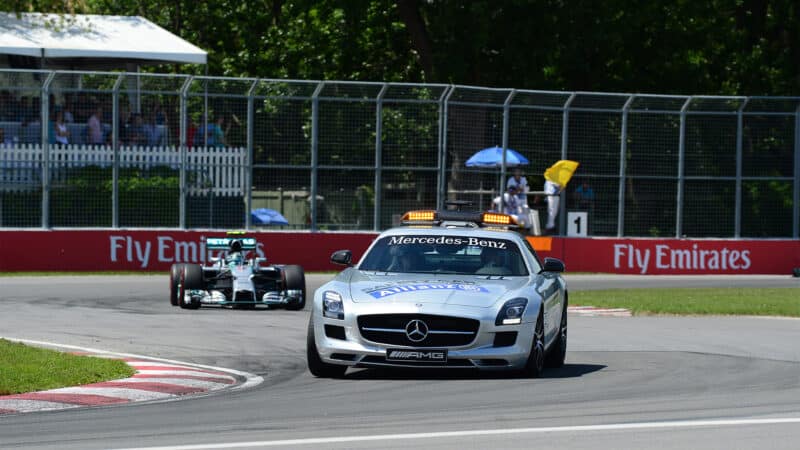
F1’s most popular safety car: the Mercedes SLS AMG
Grand Prix Photo
The Mercedes-Benz C36 AMG was a significant initial upgrade over its safety car predecessors, boasting a 3.6-litre engine and a top speed of over 155mph — more adequate for F1 speeds, although drivers continued to complain about its lap times.
It was upgraded again 1998, with the more powerful CLK 55 AMG until 1999.
With the car itself now in good hands, the next step was to find the correct driver — someone who could keep the necessary pace required by the field of drivers behind, so that tyres wouldn’t go cold and engines wouldn’t overheat. Enter Bernd Maylander — a former DTM driver and winner of the Nürburgring 24 Hours.
The German was behind the wheel of several F1 safety cars during his first decade on the job — driving a Mercedes-Benz CL55 on his debut at the 2000 Australian Grand Prix, before moving into the SL55 AMG (2001-2002), the CLK 55 AMG (2003), the SLK 55 AMG (2004-2005), the CLK 63 AMG (2006-2007) and finally the SL 63 AMG (2008-2009).
The gull-winged Mercedes SLS AMG joined the grid between 2010 and 2014, with a top speed of well over 200mph.
The modern day
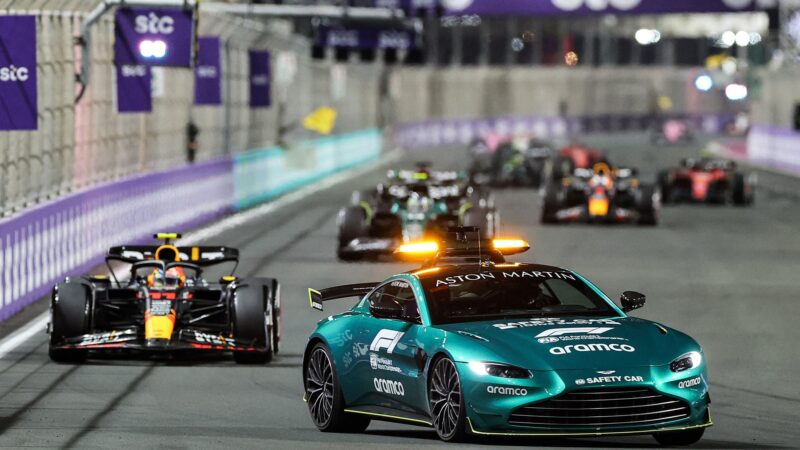
Safety car was a gift to Verstappen, closing the gaps and cutting time los in pitstop
Giuseppe Cacace/AFP via Getty Images
From 2015 onwards, the Mercedes AMG GT joined the line-up, but there was a shake-up in 2021 when the traditionally silver safety car painted red to aid driver visibility and the role was split between the German brand and Aston Martin, which runs its cars in traditional green livery.
An Aston Martin Vantage F1 edition — complete with 530bhp and 200mph top speed — is now commonly found in the pitlane, on alternate weekends to its Mercedes colleague.
Both manufacturers also supply medical cars that commonly trail the field on the opening lap in case of an accident — Mercedes using its AMG GT 63 S 4MATIC+ model while Aston use its new DBX707.
The former was the first car on the scene for Romain Grosjean‘s horrific crash at the 2020 Bahrain Grand Prix — the aid it provided being a critical reminder for why safety and medical cars are still of great importance to F1 and its drivers.
Safety car controversy in 2021
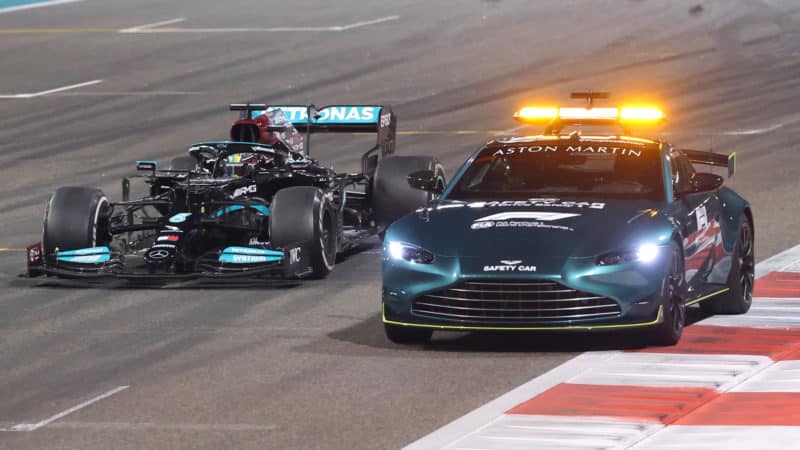
Speeded up safety car procedure in Abu Dhabi has left long shadow for F1
Giuseppe Cacace/AFP via Getty Images)
Virtually every safety car deployment affects racing, with the potential for controversy. It was the catalyst for Crashgate in 2008: Fernando Alonso pitting early at the Singapore Grand Prix before his team-mate Nelson Piquet Jr deliberately crashed. At that time, the pitlane was closed when the safety car was deployed, which allowed Alonso to close up to the rest of the field and then breeze past as they all pitted when the race resumed.
A similar to (but legal) effect helped Pierre Gasly win the 2020 Italian Grand Prix. When Kevin Magnussen stopped just by the Monza pitlane entrance, Gasly made a quick stop, just before a safety car was deployed and the pitlane closed to allow Magnussen’s Haas to be cleared. Once the rest of the field stopped, Gasly took advantage and won.
But, for most fans, mention of safety car controversy reignites the memories of Abu Dhabi 2021, when — as Jenkinson forecast 48 years previously — a late safety car led to the prospect of the race finishing in formation, not just deciding the winner of the Grand Prix, but also that year’s champion.
It would have meant an underwhelming end to a thrilling and tense season where Lewis Hamilton and Max Verstappen had battled to the bitter end. Hamilton had the edge for most of the Yas Marina race, and was leading when the safety car emerged.
